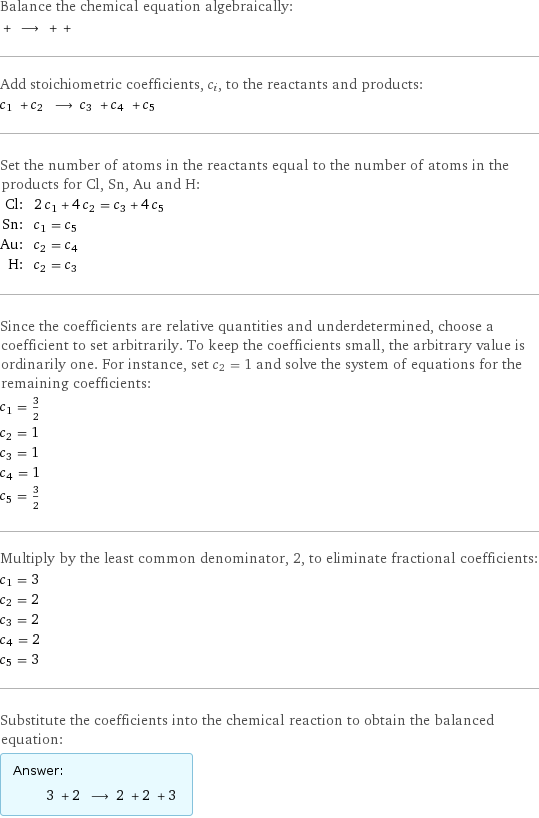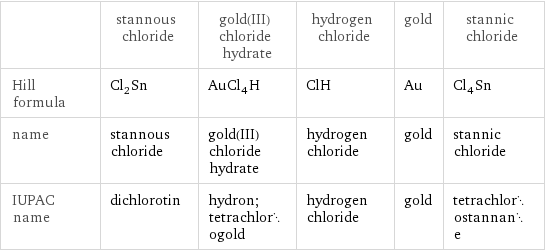Input interpretation

stannous chloride + gold(III) chloride hydrate ⟶ hydrogen chloride + gold + stannic chloride
Balanced equation

Balance the chemical equation algebraically: + ⟶ + + Add stoichiometric coefficients, c_i, to the reactants and products: c_1 + c_2 ⟶ c_3 + c_4 + c_5 Set the number of atoms in the reactants equal to the number of atoms in the products for Cl, Sn, Au and H: Cl: | 2 c_1 + 4 c_2 = c_3 + 4 c_5 Sn: | c_1 = c_5 Au: | c_2 = c_4 H: | c_2 = c_3 Since the coefficients are relative quantities and underdetermined, choose a coefficient to set arbitrarily. To keep the coefficients small, the arbitrary value is ordinarily one. For instance, set c_2 = 1 and solve the system of equations for the remaining coefficients: c_1 = 3/2 c_2 = 1 c_3 = 1 c_4 = 1 c_5 = 3/2 Multiply by the least common denominator, 2, to eliminate fractional coefficients: c_1 = 3 c_2 = 2 c_3 = 2 c_4 = 2 c_5 = 3 Substitute the coefficients into the chemical reaction to obtain the balanced equation: Answer: | | 3 + 2 ⟶ 2 + 2 + 3
Structures

+ ⟶ + +
Names

stannous chloride + gold(III) chloride hydrate ⟶ hydrogen chloride + gold + stannic chloride
Equilibrium constant
![K_c = ([HCl]^2 [Au]^2 [SnCl4]^3)/([SnCl2]^3 [HAuCl4·xH2O]^2)](../image_source/c4c81fbb13415baf102565215d6d7920.png)
K_c = ([HCl]^2 [Au]^2 [SnCl4]^3)/([SnCl2]^3 [HAuCl4·xH2O]^2)
Rate of reaction
![rate = -1/3 (Δ[SnCl2])/(Δt) = -1/2 (Δ[HAuCl4·xH2O])/(Δt) = 1/2 (Δ[HCl])/(Δt) = 1/2 (Δ[Au])/(Δt) = 1/3 (Δ[SnCl4])/(Δt) (assuming constant volume and no accumulation of intermediates or side products)](../image_source/3097f5831e750aaab560ab1fb9673e80.png)
rate = -1/3 (Δ[SnCl2])/(Δt) = -1/2 (Δ[HAuCl4·xH2O])/(Δt) = 1/2 (Δ[HCl])/(Δt) = 1/2 (Δ[Au])/(Δt) = 1/3 (Δ[SnCl4])/(Δt) (assuming constant volume and no accumulation of intermediates or side products)
Chemical names and formulas

| stannous chloride | gold(III) chloride hydrate | hydrogen chloride | gold | stannic chloride Hill formula | Cl_2Sn | AuCl_4H | ClH | Au | Cl_4Sn name | stannous chloride | gold(III) chloride hydrate | hydrogen chloride | gold | stannic chloride IUPAC name | dichlorotin | hydron; tetrachlorogold | hydrogen chloride | gold | tetrachlorostannane